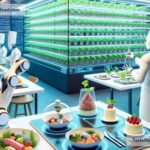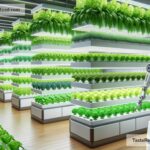The Future of Food: Transformative Global Models Shaping Tomorrow’s Plate
Food is something we all connect with—it’s what keeps us alive, brings people together, and even tells the story of culture and history. But as the world changes, so does how we grow, distribute, and consume food. With global challenges like climate change, population growth, and limited natural resources, thinkers, farmers, and governments are working hard to find solutions to ensure food for everyone while protecting the planet. Let’s explore what the future of food might look like and the innovative global models leading the way.
The Challenge: Feeding a Growing World
By 2050, the global population is expected to reach nearly 10 billion people. That means we’ll need to produce even more food than we do now—up to 70% more, according to experts. But here’s the thing: our current food system is already under pressure. Crops are affected by extreme weather patterns, water supplies are shrinking, and farmland is running out. On top of that, food production has a big impact on the environment, releasing greenhouse gases and contributing to biodiversity loss.
Clearly, we need new ways to grow food that are smarter, more sustainable, and healthier for both people and the planet.
Transforming Agriculture with Technology
Technology is playing a major role in changing how food is grown and harvested. For instance, vertical farming, where crops are grown indoors in stacked layers, is becoming more popular. These farms use LED lights to simulate sunlight, and because they’re indoors, they’re protected from bad weather and pests. Vertical farms take up much less space than traditional farming and can be set up in cities, reducing the distance food travels to consumers.
Another exciting advancement is precision agriculture, which uses tools like drones, sensors, and GPS to monitor crops closely. Farmers can now know exactly how much water, fertilizer, or pesticide their plants need. This means fewer resources are wasted, and yields can grow. Even robots are being used on farms, from planting seeds to harvesting crops.
Lab-Grown Foods and Plant-Based Alternatives
One of the most groundbreaking ideas shaping the future of food is lab-grown or “cultivated” meat. Scientists are now able to grow meat directly in laboratories using animal cells, which means producing meat without raising animals on farms. This technology could reduce greenhouse gas emissions, cut down on water use, and minimize animal suffering. While lab-grown meat is still expensive to produce today, costs are expected to drop as technology improves.
Plant-based diets are also becoming more mainstream, thanks to innovators creating alternatives to meat, dairy, and eggs. Companies like Beyond Meat and Impossible Foods are making burgers and other products that taste like meat but come from plants. These alternatives appeal not only to vegetarians but to anyone who wants to eat healthier and lower their carbon footprint.
Reducing Food Waste
Today, a third of all food produced globally—about 1.3 billion tons—goes to waste. That’s a huge problem, especially when many people in the world don’t have enough food to eat. Future food systems will place a lot of focus on reducing waste. For example, apps are being developed to connect restaurants and grocery stores with surplus food to people who need it. Additionally, food packaging is becoming smarter, with labels that show real-time freshness instead of guessing expiration dates.
Local and Community-Based Food Models
One trend we’re seeing is a shift back to local food production and distribution. Farmers’ markets are growing in popularity, and urban farming projects are popping up in cities around the world. By producing food closer to where it’s consumed, we cut down on transportation-related pollution and ensure fresher products for consumers.
Community-supported agriculture (CSA) is another model gaining attention. Consumers pay farmers upfront for a share of their harvest, creating a direct relationship between producer and buyer. This helps farmers have stable income and reduces the need for intermediaries like big suppliers.
Changing Consumer Habits
While technology and innovation can transform production, change also needs to happen on the consumer side. Today, people are becoming more mindful of what they eat and where it comes from. Eating seasonal and locally sourced food, choosing plant-based options over animal products, and reducing portion sizes are ways consumers are helping shape the future of food. Education about sustainability and nutrition will play a big role in encouraging responsible food consumption.
The Role of Governments and Policies
Global food systems are deeply interconnected, and governments play a key role in ensuring fair, sustainable practices. Policies that support research into advanced farming techniques, offer subsidies for environmentally friendly practices, and drive investment in lab-grown technologies will help set the stage for a better future. International cooperation will also be critical, especially in sharing knowledge and resources with countries more vulnerable to food insecurity.
Conclusion: A Shared Effort for a Better Future
The future of food is both exciting and challenging. Technology is paving the way for new possibilities, from lab-grown steaks to vertical farms in skyscrapers. Communities are rediscovering local farming and waste reduction. Governments are stepping up to guide policies for a more sustainable system. But most importantly, every person has a role to play through the choices they make on their plates.
By working together as individuals, businesses, and countries, we can create a food system that feeds everyone, protects the earth, and celebrates the cultures and traditions that food brings with it. The journey has already begun, and the future looks brighter—and tastier—than ever!


